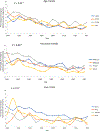Emergent colectomy rates decreased while elective ileal pouch rates were stable over time: a nationwide inpatient sample study
- PMID: 31512019
- PMCID: PMC7060938
- DOI: 10.1007/s00384-019-03375-2
Emergent colectomy rates decreased while elective ileal pouch rates were stable over time: a nationwide inpatient sample study
Abstract
Purpose: Despite advances in biologic therapy, approximately 10-15% of ulcerative colitis (UC) patients require surgery. We aimed to (1) examine the rates of emergent colectomy and elective ileal pouch anal anastomosis (IPAA) over time among UC patients in the USA and (2) investigate disparities in surgery rates by patient demographics.
Methods: Data from the Nationwide Inpatient Sample (NIS) from 2000 to 2014 were analyzed. Inclusion criteria were admissions with a primary UC ICD-9-CM diagnosis code and age > 18. Emergent cases were defined as those admitted through the emergency room with an outcome ICD-9-CM code for subtotal colectomy. Elective IPAA cases were defined with an outcome ICD-9-CM code for IPAA, used as a surrogate measure of colectomy. Patient and hospital-level demographics were analyzed. Temporal trends of colectomy were analyzed utilizing joinpoint-regression analysis with calculation of annual percentage change (APC).
Results: A total of 470,708 admissions were included over the 14-year period. Emergent colectomy rate significantly declined (APC - 7.35%, p = 0.0002), while the rate of elective IPAA remained stable (APC - 0.21%, p = 0.8). Emergent colectomy rates declined similarly across all demographics, though not as marked among patients age 50 and older and Medicare patients. Elective IPAA rates were significantly lower among blacks and patients with public insurance.
Conclusions: There has been a significant decline in emergent UC colectomy rates in the USA; however, the overall need for surgery appears unchanged given stable IPAA rates. This suggests a limited impact on overall surgery rates with a shift from emergent to elective procedures.
Keywords: Colectomy; Disparities; Ileal pouch anal anastomosis; Minority; Ulcerative colitis.
Conflict of interest statement
Figures



References
-
- Jarnerot G, Hertervig E, Friis-liby I et al. (2005) Infliximab as rescue therapy in severe to moderately severe ulcerative colitis: a randomized, placebo controlled study. Gastroenterology. 128:1805–1811 - PubMed
-
- Gustavsson A, Jarnerot G, Hertervig E et al. (2010) Clinical trial: colectomy after rescue therapy in ulcerative colitis - 3-year follow-up of the Swedish-Danish controlled infliximab study. Aliment Pharmacol Ther 32:984–989 - PubMed
-
- Sandborn WJ, Rutgeerts P, Feagan BG, Reinisch W, Olson A, Johanns J, Lu J, Horgan K, Rachmilewitz D, Hanauer SB, Lichtenstein GR, de Villiers WJS, Present D, Sands BE, Colombel JF (2009) Colectomy rate comparison after treatment of ulcerative colitis with placebo or infliximab. Gastroenterology. 137: 1250–1260 quiz 1520 - PubMed
MeSH terms
Grants and funding
LinkOut - more resources
Full Text Sources

